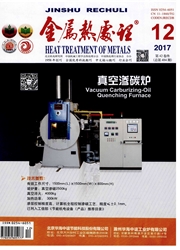

 中文摘要:
中文摘要:
利用盲孔法对分别经淬火-回火和淬火-配分处理后Fe-0.38C-1.44Mn-1.52Si-0.61Cr钢试样的残余应力进行了测量,结合试样的显微组织特征,研究了残余应力的分布规律。结果表明,两种试样内残余应力均介于热应力型和相变应力型之间,其沿试样厚度分布为W形。淬火-配分试样的残余应力低于淬火-回火试样,主要在于显微组织内存在高的残留奥氏体量和因配分被显著软化的马氏体基体。
 英文摘要:
英文摘要:
The residual stress of a medium carbon Fe-0. 38C-1. 44Mn-1. 52Si-0. 61Cr steel after quenching-tempering( QT) and quenching-partitioning( QP) treatment was measured by blind-hole method. The distribution of residual stress was studied based on the microstructural analysis. The results show that the distribution of residual stress along with thickness direction appears as approximate W shape,demonstrating the features of both thermal stress and the structural stress. The residual stress in QP specimen is smaller than that in QT one because of its high content of retained austenite and the softened martensitic matrix caused by carbon depletion in microstructure.
 同期刊论文项目
同期刊论文项目
 同项目期刊论文
同项目期刊论文
 期刊信息
期刊信息
